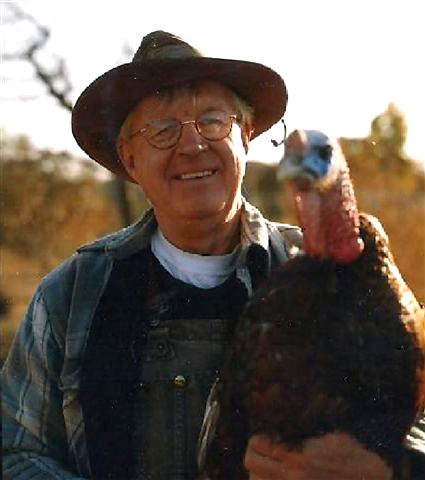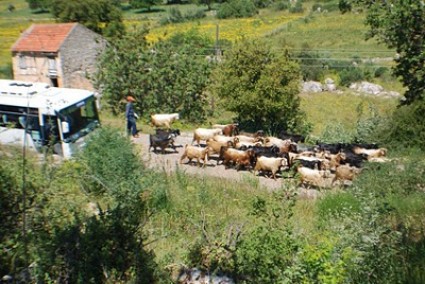AgriCulture bloggers Peter Davies and Mark Scherzer are the owners of Turkana Farms in Germantown, NY. This week Mark writes.

Arriving back at the farm after being away for nearly a month, I had the distinct impression that I was returning to a somewhat different place from the one I had left and the one I envisioned coming home to. Nothing remains the same. We left in late summer, we were startled on the night of our return to be greeted by the season’s first frost, and a heavy one at that. And having left at the tail end of a relatively dry season, we were surprised to be greeted by a water-logged world of overflowing ponds and running streams, where the geese are in their element. But there’s a downside to all this moisture. Twice in the last week we’ve had to call upon neighbors with tractors to help extract visiting trucks that got stuck in the mud. When we left, our turkey flock seemed smallish and quite manageable. We returned to birds who seemed to have doubled in size and developed strong and independent wills to wander.

Even our house was different. The conservatory room Peter had designed to replace our dilapidated basement entry and to serve as home to our subtropical outdoor plants for the winter was in mid-construction when we left. It was nearly finished on our return, and it looks terrific. However, with all there is to do, there has been little opportunity to sit and contemplate all the changes. Eli wisely harvested all the peppers in the garden just before the frost, which put immediate pressure on us to preserve them. Peter set about making lesco (a Hungarian pepper dish with tomato and onion) and freezing dozens of bags of it, while I washed and froze whole jalapenos and strung up our long red chili peppers to dry in the new conservatory. We now face taking in as much of our vegetable crop, particularly our celeriac, as possible before an impending potential snowstorm. We’ve had to immediately set about getting back to the farm’s other business as well. Having been sidelined from our usual turkey promotional activities in September (as Peter puts it, “being in Turkey instead of selling turkeys”) we’re now playing catch up on getting all our birds sold. We’ve had to figure out what to do with the 15 piglets, most of them unexpected by us, born in our absence (we’re selling them as suckling pigs, rather than taking them through the winter). We’ve had to arrange processing for our now full grown Freedom Ranger chickens. We have also confronted afresh the sometimes jarring contrast between the idealized farm we recalled from afar while traveling and the work camp (Peter calls it the gulag) that the farm can, in reality, be. We saw anew the gap between the bounty we produce and the sometimes meager income it translates into. Within that context, I’ve thought back on what we saw in Turkey, where food prices seem relatively close to what we pay here, even though incomes and national wealth are considerably lower.

At the ancient site of Patara on Turkey’s Lycian coast, where herds were grazing among the ruins, we overheard the animated bargaining between a herdswoman and a prospective purchaser of a sacrificial lamb for the upcoming Muslim Feast of the Sacrifice. As translated for us, she was asking 600 Turkish lira for one large lamb, about $340, considerably more than we would get for a similar lamb here, and this in an economy with one quarter of our gross domestic product. Peter explained to me that part of the higher price for this holiday is that families are willing to pay more in order to demonstrate their generosity, as they share parts of the lamb with poorer neighbors. Nevertheless, based on what we paid in restaurants and markets, I marveled at how Turks put a relatively higher value on their food than we Americans do, and how Turkey as a country manages through that price structure to keep a vital agricultural sector feeding a huge and growing population.

On the Istanbul tramway on my way out to the airport to return home I met a young man, Yusuf, a rug dealer who spoke excellent English. Yusuf started life as a shepherd in a rural family on the great treeless steppes of Central Anatolia until the age of 13, when his father died. We discussed some of our different animal husbandry practices, and he explained that the high lamb prices I overheard at Patara were in part the consequence of Turkish government policies restricting food imports to promote domestic agriculture. But mostly he reminisced about how much he missed shepherding. To Yusuf, city life was what produced the money he needs, but it comes with high stress. He contrasted that life with being a shepherd, a way of life, he said, that fed his soul. He recognized how hard that life was economically, yet still he idealized his memories of “sleeping under the stars," and the bond he had with his flock. It was that essence of the pastoral life he could envision returning to. I thought of Yusuf when, doing chores on my first day back, I loaded up my arms with a bunch of cornstalks from the garden to take down to the pigs. As I walked down across the pasture on a brilliant sunny fall afternoon, behind me followed Orhan, our old wether, and behind him, single file, the rest of the flock, all accompanying me on my walk. Ok, maybe they expected to get some cornstalks, but I took it as a sign of affection and pleasure at my return. Yes, these bonds are strong. For all the constant change, some things remain immutable. It’s a comforting thought. And now to business. —Mark Scherzer









